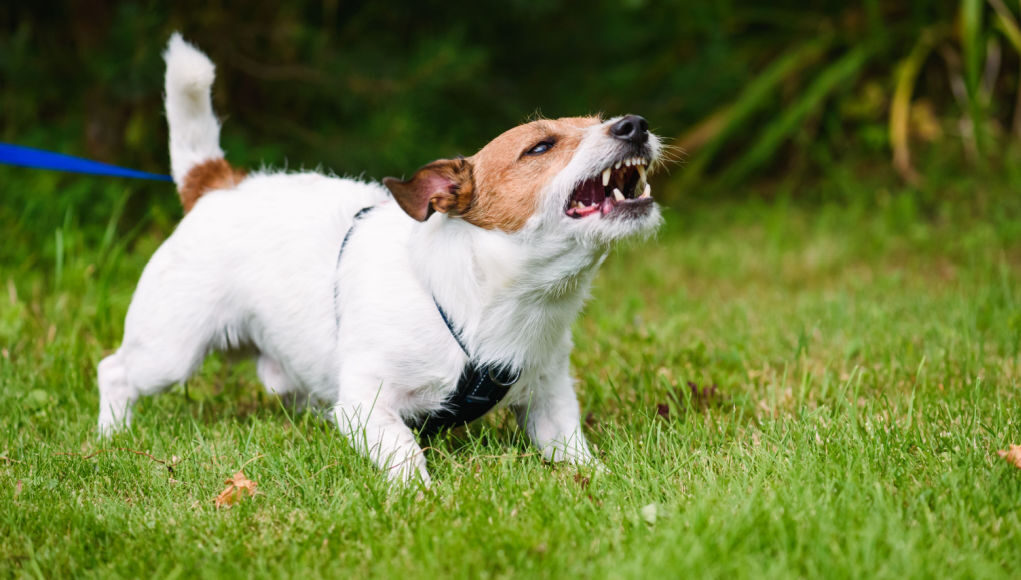Table of Contents
- Signs Your Dog is Being Overprotective of the Family
- Why Do Dogs Become Overprotective?
- Training Versus Natural Overprotection
- Naturally Protective Breeds
- Can Any Dog Become Overprotective?
- What To Do If My Dog is Overprotective?
- Looking Out for Warning Signs
- Trying to Regain Control
- Working with a Dog Trainer
- Dogs Being Overprotective of Family: Conclusion
An overprotective dog typically tries to get between its owner and anyone around it, typically when someone tries to say hello, show affection, or even comes onto the property.
The dog instinctively gets between the owner and the situation, growling and snarling in a threatening way.
This behavior isn’t only embarrassing; it can prove problematic when it tries to protect the owner from people who aren’t doing anything wrong.
Excessive protectiveness is a dangerous and frequently dangerous situation.
Eventually, dogs could resort to aggressive behaviors to prevent strangers (or loved ones) from getting too close to their owners.
The dog’s reaction is a liability, as the animal may feel compelled to bite. Even worse, these dog attacks are typically unprovoked.
In simple terms, these dogs will often attack without good reason.
Signs Your Dog is Being Overprotective of the Family
There are several signs that a dog is overprotective of you and the family.
These signs can vary depending on the age and breed of the dog but can include the following:
- Growling or lunging at strangers on the street
- The dog snarls or shows teeth to strangers or loved ones
- The dog acts aggressively around family members or strangers
- The dog will often attack unprovoked
- Unpredictable nature in new environments
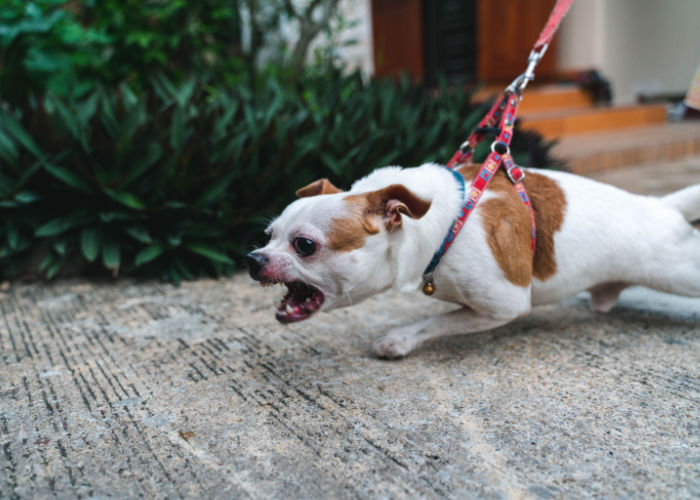
Why Do Dogs Become Overprotective?
An owner will often accidentally train their dog to become protective without realizing their contribution.
The owner will only notice the severity of the situation, not the contributing factors leading up to it.
The Dog Becomes Defensive Without Guidance
A dog develops a strong attachment with its owner, loving comfort and happiness within their environment.
These dogs understand the owner will protect them from harm, ensuring their owner meets their needs.
A dog instinctively trusts the owner, looking to him for guidance or direction.
Alternatively, an owner that fails to offer guidance and safety will never encourage reassurance.
Some dogs will feel compelled to approach life defensively. What humans perceive as “protective” may stem from insecurity and fear.
The Behavior is Accidentally Rewarded
Initially, an owner may perceive the dog’s actions as funny or reward the behavior.
When someone approaches the owner to talk or interact, the dog will growl or snarl.
The stranger suddenly stops and leaves, accidentally rewarding the negative behavior.
When a subsequent stranger approaches again, the dog will start growling again, hoping for the same reaction.
The stranger isn’t intimidated by the growling and continues to approach, causing the dog to become more aggressive in his approach.
The dog growls, showing his teeth. This time the stranger leaves.
Now the dog has learned that he must act aggressively to send strangers away. Soon, the bad habit of growling or showing teeth becomes a new behavior.
Occasionally, owners enforce the behavior, telling people, “My dog is insanely protective of me.” The owner believes that the dog protects them because the dog loves them.
Unfortunately, they’re missing a critical component: The dog is insecure, unpredictable, and reacts negatively.
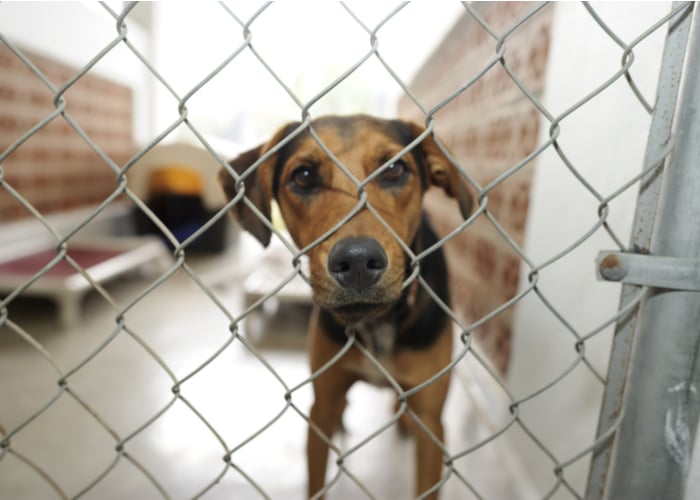
Previous Abuse
Unfortunately, 3.3 million dogs are sent to shelters annually, often for abuse and behavioral problems.
If you’ve adopted a rescue dog that came from an abusive home, it can make the dog exceptionally nervous and more reactive than average.
Thankfully, there is hope for your dog; with training and proper management, your dog can stop acting overprotective.
Lack of Routine or Structure
All dogs require schedule, structure, and rules to relax within their environment.
If you haven’t established proper boundaries, your dog will assume the alpha position, making part of its role one of protecting the family and territory.
While you don’t need to rule aggressively, having clear guidelines and rules can improve confidence and security for your dog, relaxing the protective behaviors overall.
Overprotection is Frequently Jealousy
A dog that constantly receives attention during its younger years or a canine that suddenly has to compete with another animal for companionship will often develop aggressive tendencies.
These dogs will typically fall into these categories when you’re petting another dog or hanging out with someone new.
A canine will often form a strong bond with one singular member of the family, which can occasionally cause the animal to react to others in the home.
While no one is in harm’s way, a dog can see the interaction as a perceived threat, impacting its safety overall.
For instance, playing, fighting, or goofing can launch an overprotective dog into a perceived attack.
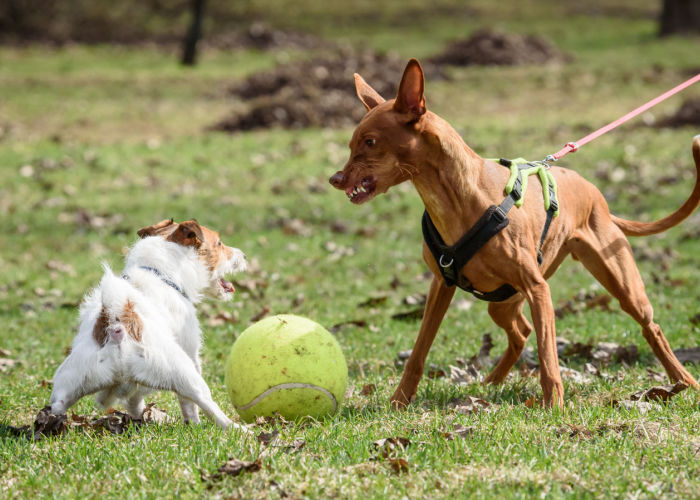
A Dog Requires Adequate Socialization
From an early age, dogs need proper socialization to accept strangers and new animals.
Proper socialization can help the dog learn to accept strangers on the property and near the family.
Other Instances Why Dogs Are Being Overprotective of the Family
Allowing an animal to become over-protective of the family can become a massive liability.
So, it's important to understand why dogs are being overprotective of the family and know the situations that could provoke your pooch to be very protective:
Sick Dog Owners
Dogs can become protective when the owner is frail or sick.
Children or Young Dog Owners
Dogs may become overprotective of children.
Although this trait doesn’t appear as a defect to owners, it frequently causes a dog to become protective when it’s not necessary. The result?
These dogs may resort to biting or growling when well-intentioned people come close.
Pregnant Dog Owners
When an owner becomes pregnant, dogs can become protective.
These dogs will often stick near the owner and block people from approaching.
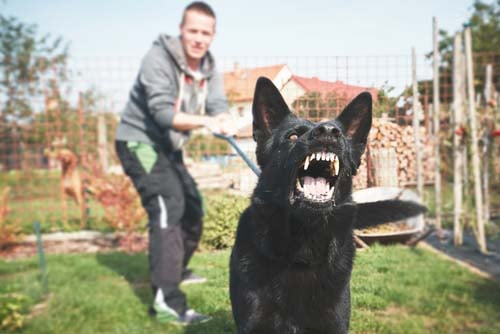
Training Versus Natural Overprotection
Regardless of the scenario, a dog should never be encouraged to become overprotective of the owner.
Dogs sent to protection training are taught to clearly understand the differences between a real threat and something not harmful.
A well-trained dog will never aggress if friends or family come over and show you affection.
Protection dogs trained by professionals are frequently excellent with kids. They must hold a solid temperament to excel in training.
Choosing the wrong personality for this protection training is an accident waiting to happen.
Naturally Protective Breeds
Some breeds will possess a natural instinct to watch their family and home, making them ideal guard dogs. A guardian breed is loyal, watchful, and strong.
If you’re looking for a dog that will protect you from dangerous situations, the following breeds are going to work well:
- Bullmastiff
- Doberman Pinscher
- Rottweiler
- German Shepherd
- Belgian Malinois
- Rhodesian Ridgeback
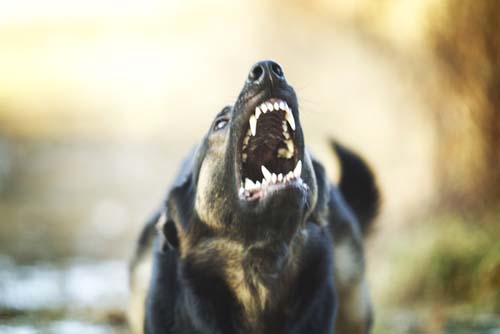
Can Any Dog Become Overprotective?
Yes. Virtually every breed of dog can become overprotective of the family.
Although some breeds are more inclined to protect, any dog may display symptoms of aggression or overprotection.
If your dog is beginning to show signs of aggression, it’s important to intercept the behaviors immediately.
When basic behavior modifications don’t work, consider hiring a professional trainer.
What To Do If My Dog is Overprotective?
Having an overprotective dog is frustrating. You want a pet that will protect you if under immediate threat, but you don’t want one that doesn’t allow regular interactions.
An overprotective dog can easily slip into aggression, which poses severe and dangerous consequences.
When a dog spends considerable time one-on-one with an owner, it can become overbearing.
After all, this individual is their source of love and food; why wouldn’t they want to protect that?
The higher value an individual is to a dog, the more likely a dog will become overprotective.
Looking Out for Warning Signs
Thankfully, there are early warning signs for overprotection in dogs.
Early signs of overprotection include placing themselves between you and other people or showing signs of heightened stress when others approach.
If you can spot these symptoms early and take immediate action, you should be able to prevent a problem from developing further.
Trying to Regain Control
Don’t allow your dog to control and run the household. Establish clear boundaries early on and ensure your dog isn’t controlling you or others in the home.
These boundaries may include setting boundaries on food, furniture, toys, or interactions within the house until the dog becomes more reliable in its response.
Offer Affection on Your Terms
Although we all enjoy spending time with our dogs, offering affection with purpose is essential.
If your dog approaches for affection, make them earn the interaction through training or tricks. Never interact with your dog when they bark at you or nudge your hand.
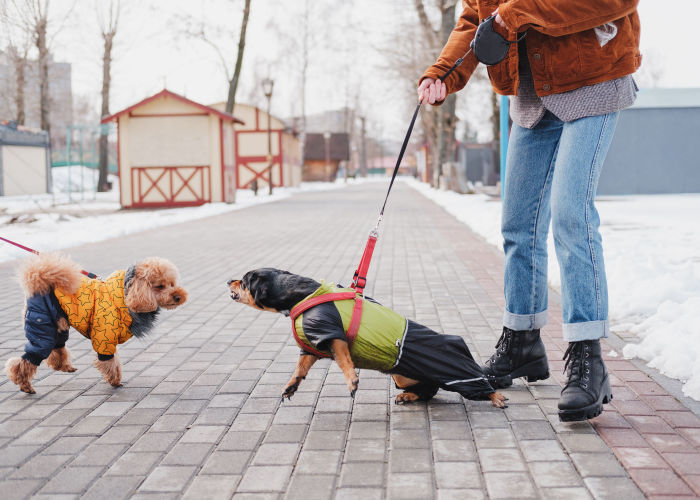
Socialize Your Dog Early On
Socializing your dog should start from an early age, as it helps prevent overprotective natures.
If your dog isn’t well socialized, speak with a canine specialist about gradually and safely exposing them to critical social aspects they may lack.
Remain Calm and Emotionless
Dogs will always pick up on your energy, whether good or bad. If you’re nervous by their behavior, they’ll increase the level of protection to protect you.
Your dog can sense when something is wrong and will always feel the need to protect you.
Occasionally, dogs become more protective when an owner is angry, vulnerable, or upset.
The animal can’t tell what is wrong precisely but want to protect and guard against the emotion.
Remain calm when you’re out with your dog and don’t show you’re nervous or anxious.
If you feel upset, take a few moments away from the dog, so they don’t react to your emotions.
Look Into Obedience Training
Enroll your dog in basic obedience training for your overprotective dog. Attend classes regularly (if it’s safe to do so).
Try to incorporate a few training sessions with your pup daily, even if only for a few minutes.
Training your dog helps encourage proper hierarchy, establishing you as the boss and trying to improve their behavior.
Developing Distance
When a dog is close to the owner, protective behaviors are probable. It’s always wise to add some distance between the overprotective dog and its owner.
Get them used to being left in a different room or with other people. Have other members of the family interact with the dog and take over walks, feeding, and training efforts.
This level of disengaging will decrease the protective nature while actively working to increase the bond with others.
Offer Mental and Physical Stimulation
A tired dog is a happy dog, making them less likely to act out.
Occasional behavior breakdown stems from minimal stimulation in their environment.
Offer plenty of exercise and keep their mind busy with activities throughout the day to see if the behaviors become less severe.
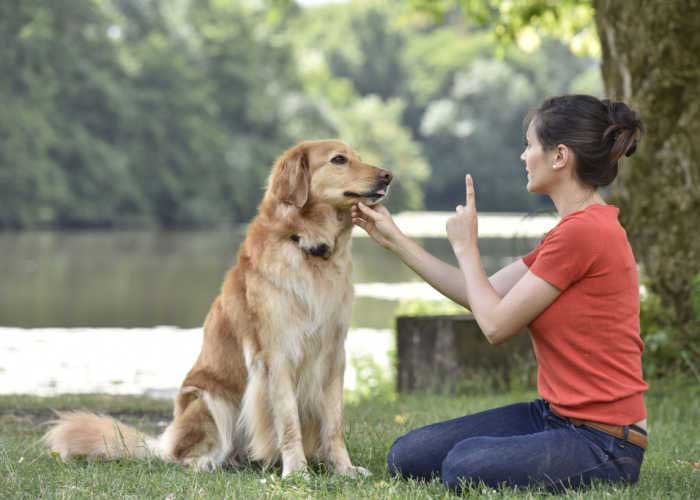
Working with a Dog Trainer
Before hiring a dog trainer, you’ll want to do your homework to make sure the individual is experienced and qualified.
Training is a pivotal point in dog ownership and behavior modification.
As the dog training industry is unregulated, anyone can call themselves a professional trainer, even those without experience.
The lack of regulation has led to an increase in pack theory, dominance-based philosophies, or other outdated theories that can increase aggression and fear in dogs.
Here are a few questions to ask your dog trainer before hiring them:
What education and experience do you possess?
If your dog trainer holds a professional dog training program, it’s a good sign.
Ask about any hands-on externships or affiliate trainers they’ve worked with.
How long have you been a trainer?
Time offers experience in the field and out.
While there’s nothing wrong with a trainer that’s newly certified, aggressive behavior is challenging to handle.
Find someone with direct experience dealing with overprotection and aggressive tendencies.
What training methods do you follow?
A trainer should try to set a dog up for success, meaning they intentionally won’t cause problematic behavior.
Look for low-conflict training methods that won’t reinforce aggressive behaviors overall.
Do you offer a guarantee?
A dog trainer should never guarantee any behavior modification or training.
A dog isn’t a machine, making them unpredictable long-term.
RELATED: Science-based Dog Training: How Research Influenced Our Approach to Training Dogs
Dogs Being Overprotective of Family: Conclusion
An overprotective dog isn’t just embarrassing; it’s dangerous.
With the risk of an unprovoked attack, getting the behavior under control is essential.
An overprotective dog is likely to react aggressively when forced into uncomfortable situations.
Behaviors like growling, putting its hackles up, bearing teeth, and nipping can quickly progress into worse behaviors.
It’s always a good idea to work with a professional trainer when struggling with overprotection instead of risking the safety and well-being of friends and family.


